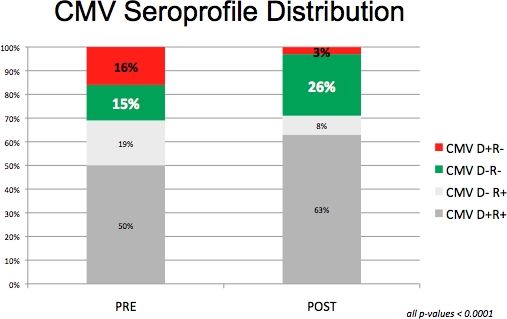Kidney Transplant Allocation with CMV Seromatching Reduces CMV Infection without Affecting Wait Times
1Transplant Nephrology, Oregon Health and Science University, Portland, OR
2Infectious Diseases, OHSU, Portland, OR
3Transplant Nephrology, University of Nebraska Medical Center, Omaha, NE
4Transplant Nephrology, Portland VA, Portland, OR.
Meeting: 2018 American Transplant Congress
Abstract number: 185
Keywords: Allocation, Cytomeglovirus, Kidney transplantation
Session Information
Session Name: Concurrent Session: CMV: Bench to Bedside
Session Type: Concurrent Session
Date: Monday, June 4, 2018
Session Time: 2:30pm-4:00pm
 Presentation Time: 2:54pm-3:06pm
Presentation Time: 2:54pm-3:06pm
Location: Room 608/609
Cytomegalovirus (CMV) infection is a major cause of morbidity and mortality in kidney transplant recipients.A pre-transplant allocation strategy by matching deceased kidney donors and recipients by CMV serostatus may reduce CMV infection.We adopted a CMV seromatching allocation policy within our Organ Procurement Organization (OPO) beginning 9/1/2012.In this retrospective analysis of 588 consecutive deceased donor kidney transplant recipients, we compared rates of CMV syndrome before (PRE:1/1/2009–8/31/2012) and after the CMV matching protocol (POST:9/1/2012–12/3/2015).Wait times for recipients within the OPO were reviewed after the protocol was implemented. CMV seromatching decreased the number of high risk CMV transplants (D+/R-) from 15.6% to 3% (P<0.0001) and increased the number of low risk CMV transplants (D-R-) from 15.3% to 25.8% (P=0.0019). CMV viremia was reduced from 16% to 8% (P=0.0024) and CMV syndrome decreased from 6.9% to 1.8% (P=0.0022).
CMV viremia was reduced from 16% to 8% (P=0.0024) and CMV syndrome decreased from 6.9% to 1.8% (P=0.0022).
| PRE
n=262 |
POST
n=326 |
|
| CMV viremia n(%)
D+R+ D+R- D-R+ D-R- |
42 (16)
22 12 7 1 |
26(3)
19 5 – 2 |
| CMV syndrome n(%)
D+R+ D+R- D-R+ |
18 (6.9)
9 5 4 |
6 (1.8)
– 3 3 |
| CMV disease n(%) | 10 (3.8) | 7 (2.1) |
| Recipients treated for CMV n(%) | 29 (11) | 7(2.1) |
| Lymphocyte depleting induction immunosupression n(%) | 118 (45) | 104 (32) |
After the allocation change, median waiting times for all recipients in the OPO did not increase and appeared to be consistent with national and regional trends. The chance that a seronegative recipient received a high risk seroprofile decreased from 51% to 12%. CMV seromatching significantly reduces the rate of CMV infection, optimizes high and low risk CMV profiles, reduces toxicities and costs associated with prophylaxis and monitoring, and does not appear to disadvantage wait times for recipients.
CITATION INFORMATION: Narra A., Strasfeld L., Basuli D., Stack M., Langewisch E., Olyaei A., Norman D., Lockridge J. Kidney Transplant Allocation with CMV Seromatching Reduces CMV Infection without Affecting Wait Times Am J Transplant. 2017;17 (suppl 3).
To cite this abstract in AMA style:
Narra A, Strasfeld L, Basuli D, Stack M, Langewisch E, Olyaei A, Norman D, Lockridge J. Kidney Transplant Allocation with CMV Seromatching Reduces CMV Infection without Affecting Wait Times [abstract]. https://atcmeetingabstracts.com/abstract/kidney-transplant-allocation-with-cmv-seromatching-reduces-cmv-infection-without-affecting-wait-times/. Accessed December 21, 2025.« Back to 2018 American Transplant Congress
